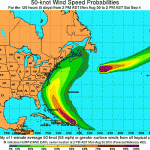According to the National Hurricane Center (NHC), Earl is now a Category 3 hurricane. FEMA continues to urge everyone in the region to take steps now to ensure they are prepared for possible severe weather, and remember that hurricanes and tropical storms frequently bring flash flooding as well. Anyone can visit www.ready.gov to learn more about how to prepare for an emergency. A Spanish version of the website is available at www.listo.gov.
 The NHC has issued a hurricane warning for the U.S. Virgin Islands, including the islands of Culebra and Vieques, which means that hurricane conditions are expected within the warning area in the next 12 hours. The NHC has issued a tropical storm warning and hurricane watch for Puerto Rico. A hurricane watch means that hurricane conditions are possible within the watch area. A hurricane watch is typically issued 48 hours before the anticipated first occurrence of tropical storm force winds, conditions that make outside preparations difficult or dangerous. A tropical storm warning means that tropical storm conditions are expected somewhere within the warning area within 36 hours.
The NHC has issued a hurricane warning for the U.S. Virgin Islands, including the islands of Culebra and Vieques, which means that hurricane conditions are expected within the warning area in the next 12 hours. The NHC has issued a tropical storm warning and hurricane watch for Puerto Rico. A hurricane watch means that hurricane conditions are possible within the watch area. A hurricane watch is typically issued 48 hours before the anticipated first occurrence of tropical storm force winds, conditions that make outside preparations difficult or dangerous. A tropical storm warning means that tropical storm conditions are expected somewhere within the warning area within 36 hours.
According to the National Hurricane Center, the center of Earl will pass near or over the northernmost part of the U.S. Virgin Islands this afternoon and evening. Hurricane conditions will be spreading across the northern U.S. Virgin Islands during the next few hours and over portions of Puerto Rico this afternoon. Rainfall is expected to produce total accumulations of 4 to 8 inches with possible isolated maximum amounts of 12 inches. These rains could cause life-threatening flash floods and mudslides.
FEMA is taking swift, proactive actions to support the U.S. Virgin Islands and the Puerto Rico islands of Culebra and Vieques as they prepare for possible landfall. FEMA already has staff on the ground in both areas working closely with commonwealth and territorial officials. FEMA has also already deployed an Incident Management Assistance Team (IMAT) to St. Thomas, and has one prepositioned in San Juan, where staff are on watch around the clock monitoring developments.
FEMA is also coordinating across the federal government to ensure commonwealth and territorial officials have the support they need. Federal and other support includes:
- Department of Health and Human Services (HHS) has deployed a Regional Extension Center (REC) to the U.S. Virgin Islands in support of the FEMA Incident Management Assistance Team (IMAT) there, and has other resources prepositioned and ready for deployment.
- Department of Defense (DOD) has activated a Defense Coordinating Officer (DCO) in St. Thomas and a State Emergency Preparedness Liaison Officer (SEPLO) team in Puerto Rico ready to support a response if needed.
- U.S. Coast Guard (USCG) has closed U S. Virgin Islands seaports and has redirected cruise ships slated for the area. Coast Guard assets are on alert and prepared to help in search and rescue efforts.
- American Red Cross has personnel on the ground in the U.S. Virgin Islands.
FEMA has life-saving and life-sustaining commodities and supplies strategically located across the country to support states in their response, including in the areas of possible impact. These supplies, including water, meals, tarps, blankets, generators and other essential items, can be replenished through the national logistics supply chain.
While there currently are no coastal watches or warnings in effect for the United States mainland, history has shown that storm tracks can change quickly and unexpectedly, and FEMA has been coordinating through its regional offices along the East Coast to aggressively prepare should the region experience severe weather.
The National Weather Service remains the source of official severe weather watches and warnings, including flash flooding which can take only a few minutes to develop in the case of heavy rains.
FEMA encourages all individuals in the region to listen to NOAA Weather Radio and their local news to monitor for severe weather updates, and to follow the directions provided by their local officials.


